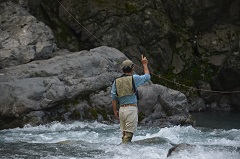Oni Blog

Once in a while, fish do not react to naturally drifting flies.
Does it happen because stream fishing has been catching on and there are more fishers?
Fish had not reacted to natural drift even before.
It may be because they are not in a mood or the time is not right or just they are not hungry.
Such info does not exist in my fishing dictionaries.
That”s when we need “sasoi.”
The pattern used for sasoi is to let the fly flutter and stand out so as to stimulate their carnivorous
instinct and appeal to their fighting instinct.
There are a myriad of fallen leaves floating on the water on a windy day and the day after high water.
Natural drift technique will only make the fly look a trash or something.
However, once it is given an action for sasoi, they consider it as a live insect and attack it as they get annoyed.
Big flies can be effective for sasoi when the water is high and deep.
Fishing of amur minnow uses dragging the fly and the floater in the shape of Japanese katakana letter “ハ”,
which also creates appealing sasoi.
This sasoi method is also used for Tenkara fishing though the effect is a bit rough.
Pounding on the surface for several times is also a good sasoi method.
The drawback after all is that since this method lets the fly move unlike natural drift,
fish can easily miss biting it.
The faster you move the fly, fish try to bit it abruptly.
If the distance for fly movement becomes long and you want fish to chase it, you can use the method of “stop and feed,”
which results in fish biting the fly more easily.
What I think is that as you feed the line following the current and stop it (in the range of 20 centimeters),
the series of slow movement makes fish calm down and relax themselves; we can be more affordable for hooking them.
Tenkara fishing combining both natural drift and other approaches in wide aspects of surface and bottom can bring in very productive results.
This is the fun and attractive part of Tenkara.
In a nutshell, Tenkara is the dialogue with fish through our techniques.
Fish individually have their own unique eyes and expressions as well as language through their body movement.
We fishermen have to read them with great care, swiftness and insight.
It’s the sport in the name of dialogue and communication, but not real fighting; we do not aim to kill them.
Their living domain is inside the water. The water is all different from place to place.
It also changes with time, weather. The countenance of the water, therefore, also changes, which we also have to read.
We have to compete with them in their domain, which is of course the water.
If you wade into the water without any care, clever fish will disappear without fail.
Fish do not come near us unless we try to blend into the nature.
This is also an important technique – how to disappear yourself.
It looks difficult, but as you gain experience and do enough research,
you will naturally have “techniques.” As you acquire them, all of sudden, Tenkara becomes your life-time friend.
COMMENTS
2 Responses to “What is SASOI (to attract fish)?”
Leave a Reply
























April 15th, 2014 @ 3:56 PM
Would it be correct to say that sasoi is every type of kebari presentation that is not natural drifting of the kebari?
Thank you.
May 3rd, 2014 @ 2:36 PM
Sasoi is one of my favorite techniques of Tenkara. It’s not the most effective for me, but it gives me my greatest satisfactions while using it.
Thank you Masami for outlining your method of the technique for us.
JDSmith